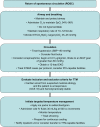Targeted temperature management in emergency medicine: current perspectives
- PMID: 27147892
- PMCID: PMC4806809
- DOI: 10.2147/OAEM.S71279
Targeted temperature management in emergency medicine: current perspectives
Abstract
Landmark trials in 2002 showed that therapeutic hypothermia (TH) after out-of-hospital cardiac arrest due to ventricular tachycardia or ventricular fibrillation resulted in improved likelihood of good neurologic recovery compared to standard care without TH. Since that time, TH has been frequently instituted in a wide range of cardiac arrest patients regardless of initial heart rhythm. Recent evidence has evaluated how, when, and to what degree TH should be instituted in cardiac arrest victims. We outline early evidence, as well as recent trials, regarding the use of TH or targeted temperature management in these patients. We also provide evidence-based suggestions for the institution of targeted temperature management/TH in a variety of emergency medicine settings.
Keywords: cardiac arrest; heart arrest; therapeutic hypothermia.
Figures

References
-
- Mozaffarian D, Benjamin EJ, Go AS, et al. Heart disease and stroke statistics – 2015 update: a report from the American Heart Association. Circulation. 2015;131(4):e29–e322. - PubMed
-
- Sasson C, Rogers MA, Dahl J, Kellermann AL. Predictors of survival from out-of-hospital cardiac arrest: a systematic review and meta-analysis. Circ Cardiovasc Qual Outcomes. 2010;3(1):63–81. - PubMed
-
- Bernard SA, Gray TW, Buist MD, et al. Treatment of comatose survivors of out-of-hospital cardiac arrest with induced hypothermia. N Engl J Med. 2002;346(8):557–563. - PubMed
-
- Hypothermia after Cardiac Arrest study group Mild therapeutic hypothermia to improve the neurologic outcome after cardiac arrest. N Engl J Med. 2002;346(8):549–556. - PubMed
-
- Busch M, Soreide E, Lossius HM, Lexow K, Dickstein K. Rapid implementation of therapeutic hypothermia in comatose out-of-hospital cardiac arrest survivors. Acta Anaesthesiol Scand. 2006;50(10):1277–1283. - PubMed
Publication types
LinkOut - more resources
Full Text Sources
Other Literature Sources

